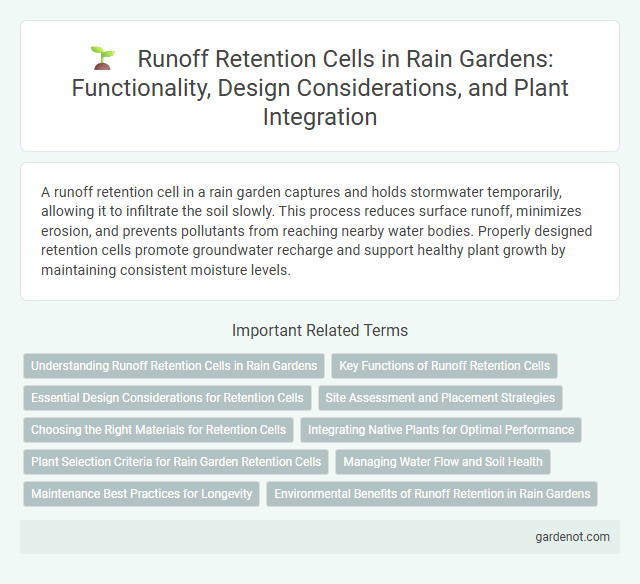A runoff retention cell in a rain garden captures and holds stormwater temporarily, allowing it to infiltrate the soil slowly. This process reduces surface runoff, minimizes erosion, and prevents pollutants from reaching nearby water bodies. Properly designed retention cells promote groundwater recharge and support healthy plant growth by maintaining consistent moisture levels.
Understanding Runoff Retention Cells in Rain Gardens
Runoff retention cells in rain gardens are designed to temporarily hold and slowly infiltrate stormwater, reducing surface runoff and preventing flooding. These cells use engineered soil media and native vegetation to enhance water absorption and pollutant filtration, improving local water quality. Properly constructed retention cells help mitigate urban runoff impacts by promoting groundwater recharge and minimizing erosion.
Key Functions of Runoff Retention Cells
Runoff retention cells efficiently capture and store stormwater runoff, reducing surface flooding and minimizing pollutant loads entering natural waterways. These cells promote infiltration, enhancing groundwater recharge while supporting plant growth that further filters contaminants. By moderating peak discharge rates, runoff retention cells help stabilize downstream ecosystems and improve overall watershed health.
Essential Design Considerations for Retention Cells
Retention cells in rain gardens are designed to capture and hold stormwater runoff, preventing excessive flow into local waterways and promoting groundwater recharge. Essential design considerations include the cell's size relative to the drainage area, soil infiltration rates, and overflow mechanisms to handle extreme rainfall events. Selecting native, water-tolerant vegetation enhances filtration and supports ecosystem health within the retention system.
Site Assessment and Placement Strategies
Runoff retention cells are critical for managing stormwater by capturing and infiltrating runoff in rain gardens, requiring thorough site assessment to evaluate soil permeability, drainage patterns, and catchment area size. Optimal placement strategies focus on locating cells in low-lying or depressional areas where water naturally accumulates, ensuring effective retention and minimizing overflow. Integrating site-specific hydrological data and topography enhances the performance of runoff retention cells in reducing peak flow and improving groundwater recharge.
Choosing the Right Materials for Retention Cells
Selecting appropriate materials for runoff retention cells is crucial to maximize infiltration and pollutant removal in rain gardens. Permeable substrates such as sandy loam or engineered soils with high porosity enhance water absorption and support microbial activity essential for breaking down contaminants. Incorporating organic matter like compost improves soil structure, promotes plant growth, and increases retention capacity, ensuring effective stormwater management.
Integrating Native Plants for Optimal Performance
Runoff retention cells maximize stormwater infiltration and pollutant filtration by integrating native plants adapted to local soil and climate conditions. Deep-rooted native plants enhance soil structure, improving water retention capacity and promoting microbial activity essential for contaminant breakdown. Selecting diverse native species with varied root depths optimizes runoff absorption and supports resilient, sustainable rain garden ecosystems.
Plant Selection Criteria for Rain Garden Retention Cells
Plant selection criteria for rain garden runoff retention cells prioritize species with high water tolerance, deep root systems, and native adaptability to efficiently manage stormwater. Plants such as sedges, rushes, and wetland grasses enhance infiltration and reduce runoff by holding soil and promoting evapotranspiration. Selecting diverse, native plants also supports local biodiversity and ensures long-term resilience of rain garden retention cells.
Managing Water Flow and Soil Health
Runoff retention cells in rain gardens are engineered to capture and temporarily store stormwater, reducing surface runoff and promoting groundwater recharge. These cells utilize native soil and organic matter to enhance infiltration rates while filtering pollutants, thereby improving soil health and water quality. By managing water flow effectively, runoff retention cells mitigate erosion and support sustainable urban drainage systems.
Maintenance Best Practices for Longevity
Regular inspection and removal of debris from runoff retention cells ensure unobstructed water flow and prevent clogging. Periodic pruning of vegetation and replenishment of mulch support plant health and enhance infiltration capacity. Maintaining proper soil conditions through aeration and avoiding compaction prolongs system effectiveness and longevity.
Environmental Benefits of Runoff Retention in Rain Gardens
Runoff retention cells in rain gardens significantly reduce stormwater runoff by capturing and infiltrating rainwater, which helps prevent erosion and decreases pollutant loads entering local waterways. These systems enhance groundwater recharge and improve water quality by filtering contaminants such as sediments, nutrients, and heavy metals through vegetation and soil layers. By mitigating urban flooding risks and supporting native plant habitats, runoff retention cells contribute to increased biodiversity and healthier urban ecosystems.
Runoff retention cell Infographic

 gardenot.com
gardenot.com